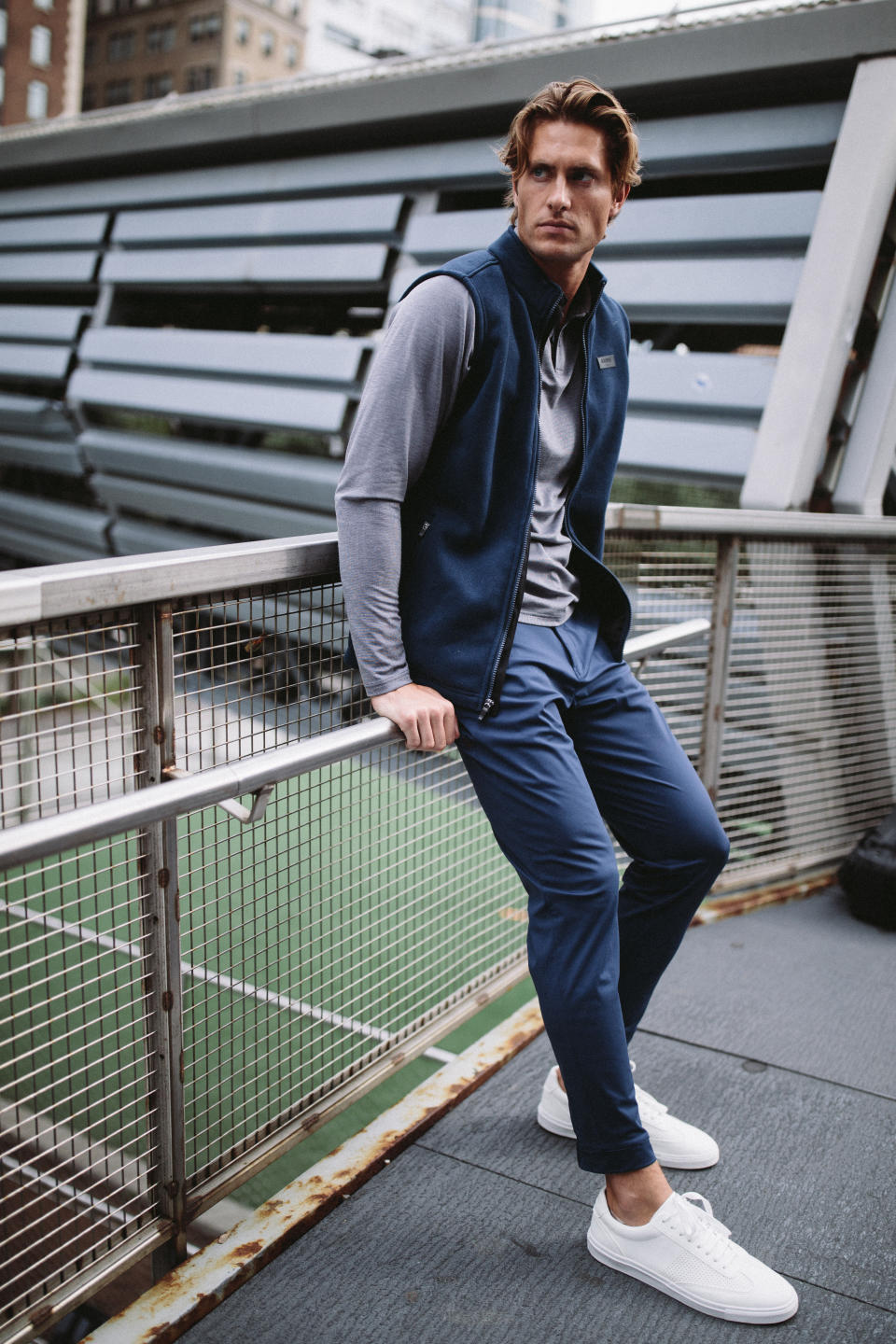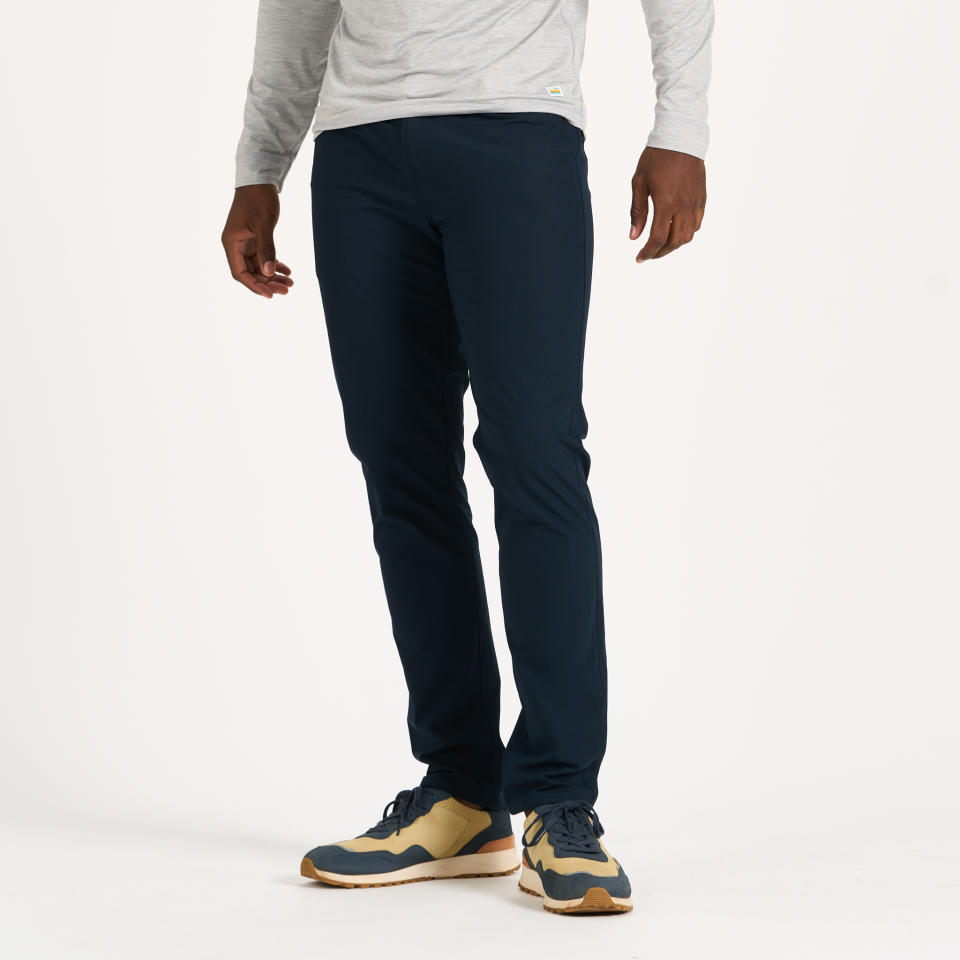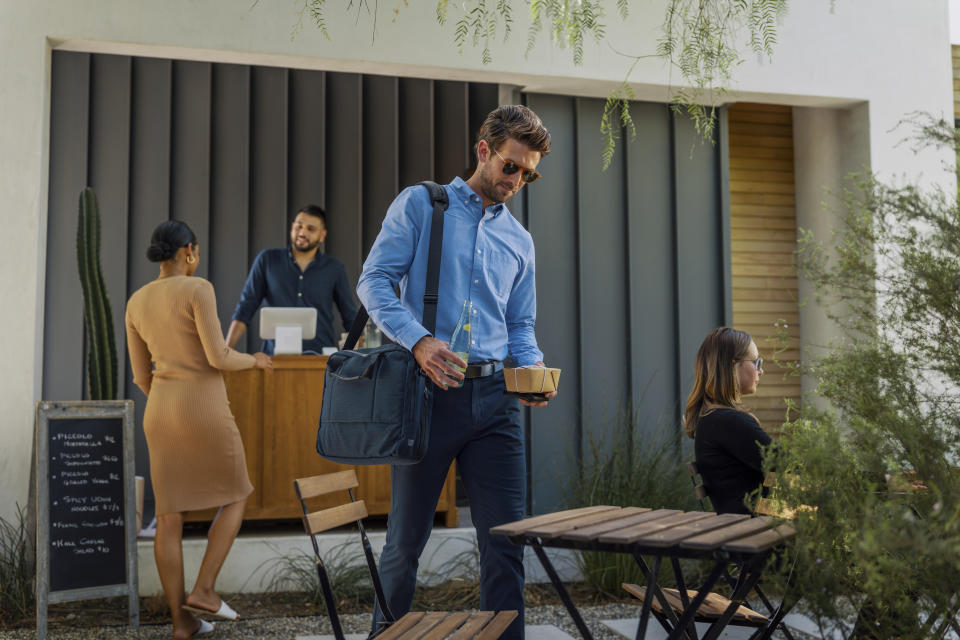Technical Features Modernize the New Work Wardrobe

Comfort, comfort and more comfort — that’s what’s going to define the wardrobe for guys heading back to the office this fall.
After spending more than a year camped out at home in sweatpants and shorts — with a dressier shirt for all those Zoom meetings — men are demanding flexibility in both their wardrobe and their work life. With the Delta variant causing some companies to delay the return of workers until later this year and others allowing a hybrid schedule, wardrobes are expected to be flexible as well.
More from WWD
The days of wearing tight, fitted suits, cotton dress shirts and ties are over for most men. Instead, they’re opting for shirts and pants with stretch, wrinkle resistance, wicking and other performance attributes that they got used to in their activewear during the height of the pandemic. But they need to look professional and polished at the same time.
These demands are being addressed by many of the brands they gravitated to during the health crisis, which are expanding their reach to offer a more tailored alternative.
Doug Wood, chief executive officer of Tommy Bahama, said: “The whole world is now casual, and if a guy is going somewhere, he wants to feel cool and look good. Even in 2019, before the pandemic, we had seen a move toward performance.” He gave credit to Lululemon as being at the forefront of this movement to “bring performance into sports.”
Taking a page from that playbook, Tommy Bahama brought its own version to market with its IslandZone collection, which includes performance pants and tops, along with pieces such as the Boracay blazer, Delray Fronds polo, Tobago Bay full-zip sweatshirt and even its signature camp shirts in more subdued solid colors.
The customer is responding. Wood said the top-selling item for the brand is the Palm Coast polo within the IslandZone collection, which is made from recycled polyester and is offered in 19 colors. Other top sellers include a long-sleeve half zip.
New pieces finding fans include the Chip Shot IslandZone performance short — the brand’s second bestselling item — which offers stretch and technical features in a sleek silhouette. “Our [customers] are looking for stretch and performance in their bottoms,” he said. “And something that is casual but looks nice and performs. We got in front of that prior to COVID-19 and now that’s all he wants.”
As a result, Tommy Bahama has managed to navigate its way well through the pandemic. Wood said the company looked back at the recessionary years in 2008 and 2009 for lessons and worked hard to “make sure we had a strong brand when the customers came back.” The brand was also able to take the inventory that it had stockpiled when its stores were closed last spring and stock its boutiques with fresh merchandise this year.
It also served as a good hedge against the current supply chain issues facing the industry. “There isn’t anyone who isn’t running into issues,” Wood said. With COVID-19 causing factories in other countries to close or scale down and significant delays in shipping, companies are doing their best to adapt by ordering earlier and reducing inventories. “If you go back to February 2020, we didn’t know the storm we were headed into,” Wood said. “But we’re working seven days a week with our factories so we think we’ll be in fine shape for holiday.”
Rhone, too, has benefited from the new work wardrobe as the brand moves beyond its roots in activewear to provide its customers with more options.

“Men are focused on comfort more than anything else today,” said Nate Checketts, Rhone’s CEO and cofounder. “As people begin to transition back to the office, there’s going to be a more flexible work schedule and a more comfortable work environment — and our ‘uniform’ has to match our new work life.”
Enter the Commuter Collection. “These trends started three to four years ago and the pandemic just accelerated it,” Checketts said. “When I see someone in an itchy, tight cotton dress shirt, I just feel sorry for them.”
Instead, the Commuter shirt looks like a traditional button-down, but it’s lightweight and offers four-way stretch, natural wrinkle release and moisture wicking. Ditto for the Commuter pant and short.
“Forget casual Fridays, you can get away with that all week now,” he said. “So everything today must offer a greater flexibility for the new workplace.”
Checketts said the Commuter dress shirt didn’t even crack the top 20 of the brand’s bestselling items before the pandemic, but since May, it has consistently landed in the top three to five every week. “Last year, it was all about loungewear and activewear,” he said,” but this year, it’s all about the Commuter line.”
Rhone is seeking to drive even more men to its brand by putting heightened emphasis on the collection in all its marketing channels. “We’re telling guys there is an option between a T-shirt and an itchy cotton dress shirt and there are lots of ways to look professional and still be comfortable.”
Joe Kudla, founder and CEO of Vuori, has also embraced what he calls “travel commute — aka work leisure. Our business in this category is exploding and we see the opportunity to [quadruple sales] over the next three years. If men weren’t already into comfort and athleisure before, they are now.”

For Vuori, that means pants that move and are breathable but look good enough to meet the demands of a hybrid workplace. “Our business is rooted in fitness, but technical sportswear for the office or the golf course was growing even before the pandemic,” he said. “And it will grow north of 30 percent over the next three years.” Vuori’s “anchor” product is its $98 MetaPant, a classic five-pocket silhouette in a knit material that “wears like a woven. That represents a very big business for us.”
In tops, it’s the soft, moisture-wicking Strato fabric that the brand originally used in tees that has been extended into polos, which Kudla said has grown into the brand’s most popular travel commute top. Vuori also offers an Ace long-sleeve button-down in a performance pique that works well with a dress pant.
Going forward, the plan is to offer more chinos, button-downs and polos, along with quarter- and half-zips in technical fabrics to address demand. This will also help fill the stores the company will be rolling out. Already at nine units, Vuori expects to have 14 stores in operation by the end of the year and add another 15 to 20 next year, including a flagship in SoHo.
Brian Berger, founder and CEO of Mack Weldon, which started out as an underwear brand, has also seen increased interest in the brand’s dressier options.

The brand was planning to introduce a new technical chino in April 2020, but when the pandemic hit, Mack Weldon slammed on the brakes. “It was going to be our third major bottoms introduction, but we shelved it,” he said. Although the brand quietly put the Maverick, with its tailored, clean fit and stretch fabric, on the web site, it was Mack Weldon’s sweats and loungewear that turned into its hero products during the health crisis.
More recently, things have changed and the brand’s “smart, casual products” have seen “a real pickup in demand,” Berger said.
The company’s web site has a section devoted to The Operator, which is targeted to the working guy, with oxford shirts, polos, chinos shorts and pants, puffer vests, underwear and socks with technical features.
“There’s a mass casualization going on and tech-infused, innovative, lifestyle apparel will dominate the day,” he said. “It’s a crisp, modern look that is not necessarily a suit or tie or uniform. There will be a lot more flexibility and these products will play into that.”
Sign up for WWD's Newsletter. For the latest news, follow us on Twitter, Facebook, and Instagram.